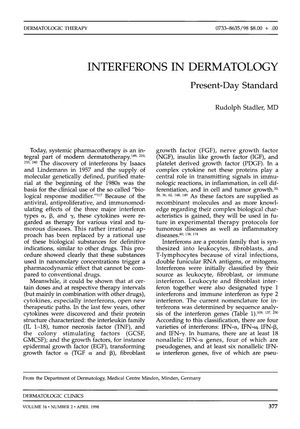Interferons in Dermatology
April 1998
in “
Dermatologic Clinics
”

TLDR Interferons are effective for some skin conditions and cancers, but can have side effects and need more research for optimal use.
In the 1998 document, interferons (IFNs) were discussed as a treatment option in dermatology for their antiviral, antiproliferative, and immunomodulatory effects. IFN-α was highlighted for its effectiveness in treating conditions such as genital warts, Kaposi's sarcoma, hemangioma, and cutaneous T-cell lymphoma (CTCL). Studies showed significant efficacy of IFN-α in treating condylomata acuminata and genital warts in women, with response rates over 50% for Kaposi's sarcoma in AIDS patients, and high success rates for life-threatening hemangiomas. IFN-α was approved worldwide for CTCL therapy, with response rates between 75% and 85%. Combination therapies, such as IFN-α with PUVA or retinoids, showed promise in CTCL treatment, with a multicenter study involving 98 patients indicating a higher rate of complete responses with the IFN-α plus PUVA group. For malignant melanoma, IFN-α was approved by the FDA as adjuvant therapy, with high-dose regimens prolonging relapse-free intervals and overall survival, despite significant toxicity. IFN-α and IFN-ß were also considered for basal cell carcinoma, with IFN-α being cost-effective in some cases. While IFN-α showed potential in autoimmune diseases and other conditions, it was not effective for psoriasis vulgaris and could even trigger it. Side effects of IFNs were generally mild and reversible, with common symptoms including flu-like symptoms, fatigue, and moderate alopecia. The document concluded that further research was needed to optimize the clinical use of interferons and manage their toxicities.





